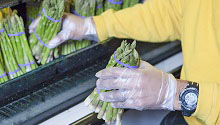Net Grocery Spending Rises for First time in Three Years
Washington, D.C., February 22, 2011 – After a number of years in which consumers implemented a variety of money saving measures at the meat case, the world of grocery shopping appears to be reaching a new balance, with net spending rising for the first time in three years, according to the sixth annual The Power of Meat study. The study, conducted by 210 Analytics, was commissioned jointly by the American Meat Institute (AMI) and the Food Marketing Institute (FMI) with generous sponsorship by Sealed Air’s Cryovac Food Packaging Division.
While some shoppers still spent less on groceries than they did a year ago, the share of shoppers who have made changes to their meat and poultry purchases as a result of the economy declined for the second year in a row, down from 51 percent in 2009 to 36 percent today. Overall, the share of shoppers who cut their total food spending (restaurant and grocery spending combined) compared to 12 months prior is down by 17 percent.
The report, which details the findings of a national online poll of 1,201 consumers conducted in November 2010, was released today at the 2011 Annual Meat Conference in Dallas, Texas.
Supermarkets Remain a Meat Stronghold
As the economy continues to struggle, higher prices and lower disposable incomes may yet again shake up the status quo in the way people buy groceries. One thing, however, hasn’t changed: the meat department continues to be a key differentiator for full-service supermarkets. Supermarkets maintained their market share as respondents’ primary store for meat and poultry purchases at 68 percent. When taking a look at shoppers who identify their primary store as a supermarket, the vast majority, 88 percent, also purchase meat there.
“Clearly, supermarkets are finding ways to maintain their customers’ business to a major extent in the midst of an extremely difficult business environment,” the report concluded.
Meat Purchasing Patterns
Occasional deal seekers have now become dedicated bargain hunters, with fully three-quarters of shoppers reporting that they research meat deals either before going to the store by means of a circular or specials posted online or in the store. Nine out of 10 shoppers compare prices when shopping in the meat department, making it clear that signage is key to maximizing the sales opportunity.
Bulk purchases, on the other hand, are less popular than in the past two years.
“Spending less by buying less appears to be an effective measure,” the report stated. “Shoppers who say they are buying less spend nearly $14 less than the national weekly grocery bill average. For retailers, elimination of items rather than substitution is a dangerous development. Shoppers are also less interested in family packs and report that more substantial discounts are needed to prompt them to purchase in bulk.”
Price per pound is the dominant factor in selecting meat and poultry, the report found. Marketing and merchandising measures are especially influential on the kind of meat or poultry purchased, but also influence the quantity. In-store sales promotions are key drivers and as such, good signage is key to maximize the meat purchase. Coupons are of interest also, but shoppers commented that fresh meat coupons are hard to find.
The majority of purchases continue to come from the meat case as opposed to the service counter. The quality perception of case-ready meat reached its highest point in the six-year history of this survey. At the same time, the lowest share of shoppers since the start of the survey say they would think more highly of the quality of the meat if processed at a USDA-certified facility. Leak-proof, or vacuum-sealed, packaging is catching on with shoppers with both an increased awareness of the concept and increased usage. Environmentally-friendly packaging, on the other hand, is met with only mild interest that does not allow for any price premiums over conventional packaging.
Some three years after mandatory country-of-origin labeling went into effect, one-third of shoppers report noticing the labels — predominantly directly on the package. The of shoppers share willing to pay more for U.S. raised and processed meat and poultry is the same as before at about one-third of shoppers.
Home-Cooked Meals Making a Comeback
Shoppers prepare an average of four home-cooked meals containing a meat or poultry item per week. But while home-cooked meals made a strong comeback, shoppers don’t necessarily know how to cook meat and poultry. Less than half consider themselves very knowledgeable in areas such as cooking meat, poultry and seafood, and significant numbers admit room for improvement on things like picking sides that match the meat’s flavor profile, pairing the right wine with the meal, marinating and spicing meat and poultry, and even the USDA beef grading system. Education methods popular among these shoppers include recipes surrounding the items featured in the weekly sales ad and online tips. Among smart phone users, interest in apps teaching them more about meat and poultry is high.
Chicken and beef continue to dominate the dinner plate, but this year the survey noted a rise in heat-and-eat meats while the consumption of fresh meat remained flat. This is another indication of market recovery, with a shift from saving to convenience for at least some shoppers. Marinated meats also gained in popularity. This comes along with a growing general interest in spicier and more flavorful foods, especially as ethnic foods are going mainstream.
Healthy Eating Strategies
When it comes to healthy eating, respondents said they were most likely to cut back on portion sizes or second helpings, followed by choosing foods that are lower in sodium than their regular counterparts. A majority said they are not willing to give up meat regularly compared to those who have implemented “meatless Mondays” (26 percent versus 18 percent).
Healthy eating strategies relative to protein consumption differ widely by gender, age, income and other factors. Women are much more likely to limit their meat and poultry consumption, for example.
Overall, shopper frugality is resulting in a lesser focus on eating healthfully. Fewer shoppers are checking the nutrition facts panel when purchasing fresh and processed meat and the number of shoppers who say they succeed in eating a healthy diet regularly is down compared to previous years.
Regarding nutrition information, shoppers continue to check this information most frequently for processed meat, with 29 percent doing so every time and 37 percent sometimes.
“Healthy eating in 2011 primarily focuses on portion control and minimizing sodium intake. Additionally, shoppers scan for the fat content and calories, and are starting to focus a little more on what to include as opposed to what to avoid,” the report stated.
While shoppers’ attention remains on ?light, ?low and ?no, there seems to be somewhat of a shift in focus to items that shoppers want to include in their diets such as protein, fiber and various vitamins. While attributes they are trying to limit or avoid did not score as highly, each of these attributes grew in importance compared with 2010 ratings.
“While subtle, this shift could lead to growing interest among shoppers for manufacturers and retailers to tout the benefits of meat and poultry more clearly, such as protein, iron and low carbohydrates,” the report suggested.
Organic and Natural Meat
The economy has been a real proving ground for organic and natural meat. While the category did not experience significant growth, it did not decline either. A steady one in five shoppers has purchased natural and/or organic meat or poultry in the past three months. With strong belief in the positive long-term health effects of organic meat and poultry, shoppers are unwilling to give up this choice even if they only purchase organic for certain kinds or cuts of meat.
Shoppers name a growing variety of reasons for purchasing organic meat and poultry. The most significant reason is perceived long-term health benefits from the consumption of organic meat and poultry (44 percent) as well as a belief ( 37 percent) that the primary benefit is better health and treatment of the animal. One-third of shoppers also cited perceived better nutritional value, better taste and freshness as a key factor in organic meat and poultry purchases.
Improving the Meat Department
Lastly, the survey probed ways retailers can improve the meat department to encourage meat and poultry purchases. As shoppers try to save money when purchasing groceries, including meat and poultry, one popular measure is the minimizing of impulse purchases. Many shoppers carefully research the upcoming trip, prepare lists and stick to the list as much as possible. Fully 40 percent of shoppers — double the share of that in 2007 — say nothing retailers do will persuade them to purchase more, challenging retailers in their marketing and merchandising efforts. Others say better quality and variety would prompt increased purchases.
When respondents were asked what improvements could be made to shopping in the meat department, comments ranged from variety and freshness to cleanliness and signage. Many of the suggestions pertained to price, including comments about lowering prices as well as better specials, more coupons, meal deals and bulk discounts.
Food Marketing Institute (FMI) conducts programs in public affairs, food safety, research, education and industry
relations on behalf of its 1,500 member companies — food retailers and wholesalers — in the United States and
around the world. FMI’s U.S. members operate approximately 26,000 retail food stores and 14,000 pharmacies.
Their combined annual sales volume of $680 billion represents three-quarters of all retail food store sales in the United States. FMI’s retail membership is composed of large multi-store chains, regional firms and independent
supermarkets. Its international membership includes 200 companies from more than 50 countries. FMI’s associate members include the supplier partners of its retail and wholesale members.
AMI represents the interests of packers and processors of beef, pork, lamb, veal and turkey products and their
suppliers throughout North America. Together, AMI’s members produce 95 percent of the beef, pork, lamb and veal
products and 70 percent of the turkey products in the United States. Headquartered in Washington, D.C., the
Institute provides legislative, regulatory, public relations, technical, scientific and educational services to the industry. Its affiliate, the AMI Foundation, is a separate 501(c)3 organization that conducts research, education and
information projects for the industry.
 Industry Topics address your specific area of expertise with resources, reports, events and more.
Industry Topics address your specific area of expertise with resources, reports, events and more.
 Our Research covers consumer behavior and retail operation benchmarks so you can make informed business decisions.
Our Research covers consumer behavior and retail operation benchmarks so you can make informed business decisions.
 Events and Education including online and in-person help you advance your food retail career.
Events and Education including online and in-person help you advance your food retail career.
 Food Safety training, resources and guidance that help you create a company food safety culture.
Food Safety training, resources and guidance that help you create a company food safety culture.
 Government Affairs work — federal and state — on the latest food industry policy, regulatory and legislative issues.
Government Affairs work — federal and state — on the latest food industry policy, regulatory and legislative issues.
 Get Involved. From industry awards to newsletters and committees, these resources help you take advantage of your membership.
Get Involved. From industry awards to newsletters and committees, these resources help you take advantage of your membership.
 Best practices, guidance documents, infographics, signage and more for the food industry on the COVID-19 pandemic.
Best practices, guidance documents, infographics, signage and more for the food industry on the COVID-19 pandemic.
